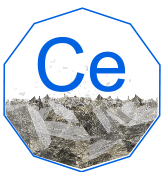Cerium

Cerium (Ce)
General Information
- Symbol: Ce
- Atomic Number: 58
- Atomic Weight: 140.116 u
- Element Category: Lanthanide
- Group: N/A (Lanthanides series)
- Period: 6
- Block: f-block
Physical Properties
- Appearance: Silvery-white metallic
- Density: 6.77 g/cm³
- Melting Point: 798 °C (1468 °F)
- Boiling Point: 3443 °C (6229 °F)
- Phase at STP: Solid
- Electron Configuration: [Xe] 4f¹ 5d¹ 6s²
- Oxidation States: +3, +4 (most common)
Chemical Properties
- Reactivity: Cerium is quite reactive, tarnishing readily in air. It reacts with water to form cerium hydroxide and with acids to form cerium salts.
- Compounds: Forms compounds such as cerium(IV) oxide (CeO₂), cerium(III) chloride (CeCl₃), and cerium(III) nitrate (Ce(NO₃)₃).
Uses and Applications
- Catalysts: Used in catalytic converters in the automotive industry to reduce emissions.
- Glass Polishing: Cerium(IV) oxide is widely used for polishing glass and in the production of precision optics.
- Alloys: Added to alloys to improve heat resistance and strength, particularly in lighter flints for lighters.
- Phosphors: Utilized in phosphors for TV screens and fluorescent lamps.
- Chemical Oxidizing Agent: Used in organic synthesis as an oxidizing agent.
Occurrence and Extraction
- Natural Occurrence: Found in minerals such as monazite and bastnasite.
- Extraction: Extracted through complex processes involving the crushing of ore, magnetic separation, and solvent extraction.
Isotopes
- Stable Isotopes: Cerium-140 (most abundant), Cerium-142
- Radioactive Isotopes: Cerium-144 (used in research and medicine)
Safety and Handling
- Hazards: Cerium is considered to have low toxicity, but cerium compounds should be handled with care to avoid inhalation or ingestion. Cerium dust is a fire and explosion hazard.
- Precautions: Use appropriate protective equipment when handling cerium and its compounds.
History
- Discovery: Discovered by Martin Heinrich Klaproth, Jöns Jakob Berzelius, and Wilhelm Hisinger in 1803.
- Name Origin: Named after the asteroid Ceres, which was discovered two years earlier.
Additional Facts
- Crystal Structure: Face-centered cubic (fcc)
- Magnetic Properties: Paramagnetic
- Thermal Conductivity: 11.3 W/m·K
- Electrical Resistivity: 828 nΩ·m at 20°C
Summary
Cerium is a versatile lanthanide with a wide range of applications in industry and technology. It is particularly valuable in catalytic converters, glass polishing, and as an alloying agent. Discovered in 1803 and named after the asteroid Ceres, cerium is relatively abundant and is found in several minerals. Despite its reactivity, it is considered to have low toxicity, though proper precautions should be taken when handling its compounds.
40 Question and Answer Pairs About Cerium
What is the atomic number of Cerium?
- 58
What is the symbol for Cerium?
- Ce
What is the atomic weight of Cerium?
- 140.116 u
In which group of the periodic table is Cerium found?
- Lanthanides series (no specific group)
What period is Cerium in?
- Period 6
What block does Cerium belong to?
- f-block
What is the density of Cerium?
- 6.77 g/cm³
What is the melting point of Cerium?
- 798 °C (1468 °F)
What is the boiling point of Cerium?
- 3443 °C (6229 °F)
What is the electron configuration of Cerium?
- [Xe] 4f¹ 5d¹ 6s²
What are the common oxidation states of Cerium?
- +3, +4
What is the appearance of Cerium?
- Silvery-white metallic
Is Cerium reactive with air?
- Yes, it tarnishes readily in air.
Name a compound of Cerium.
- Cerium(IV) oxide (CeO₂)
What is a common use of Cerium in the automotive industry?
- In catalytic converters to reduce emissions.
How is Cerium used in the glass industry?
- For polishing glass and in the production of precision optics.
What role does Cerium play in alloys?
- It improves heat resistance and strength.
How is Cerium used in lighting?
- In phosphors for TV screens and fluorescent lamps.
What is a chemical application of Cerium?
- As an oxidizing agent in organic synthesis.
How is Cerium typically found in nature?
- In minerals such as monazite and bastnasite.
What is the most abundant isotope of Cerium?
- Cerium-140
What safety hazard is associated with Cerium dust?
- It is a fire and explosion hazard.
Who discovered Cerium?
- Martin Heinrich Klaproth, Jöns Jakob Berzelius, and Wilhelm Hisinger
Where does the name Cerium come from?
- Named after the asteroid Ceres.
What is the crystal structure of Cerium?
- Face-centered cubic (fcc)
Is Cerium paramagnetic or diamagnetic?
- Paramagnetic
What is the thermal conductivity of Cerium?
- 11.3 W/m·K
What is the electrical resistivity of Cerium at 20°C?
- 828 nΩ·m
What is the primary oxidation state of Cerium in its compounds?
- +4
Is Cerium found as a free element in nature?
- No, it is found in minerals.
What is the common name of Cerium(III) nitrate?
- Ce(NO₃)₃
What is a major application of Cerium in the automotive industry?
- Catalytic converters
How does Cerium benefit glass polishing?
- Cerium(IV) oxide is used for its polishing properties.
What is the melting point of Cerium in Kelvin?
- 1071 K
What group does Cerium belong to in the periodic table?
- Lanthanides series
What is the natural abundance of Cerium-140?
- It is the most abundant isotope.
Can Cerium be used in high-temperature applications?
- Yes, in alloys to improve heat resistance.
What is the key property that makes Cerium valuable in catalytic converters?
- Its ability to reduce emissions.
How is Cerium used in the chemical industry?
- As an oxidizing agent.
What precautions should be taken when handling Cerium?
- Use appropriate protective equipment to avoid inhalation or ingestion.


 4.1 Attribution Theory and Person Perception: Why We Judge People the Way We Do (Even When We’re Totally Wrong) Let’s be honest. We’ve all
4.1 Attribution Theory and Person Perception: Why We Judge People the Way We Do (Even When We’re Totally Wrong) Let’s be honest. We’ve all



